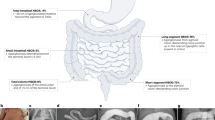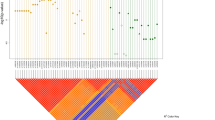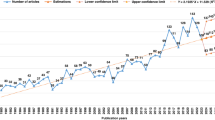Abstract
Hirschsprung disease (HSCR), a congenital disorder characterized by intestinal obstruction due to absence of enteric ganglia along variable lengths of the intestinal tract, occurs both in familial and sporadic cases. RET mutations have been found in approximately 50% of the families, but explains only a minority of sporadic cases. This study aims at investigating a possible role of RET in sporadic HSCR patients. Haplotypes of 13 DNA markers, within and flanking RET, have been determined for 117 sporadic HSCR patients and their parents. Strong association was observed for six markers in the 5′ region of RET. The largest distortions in allele transmission were found at the same markers. One single haplotype composed of these six markers was present in 55.6% of patients versus 16.2% of controls. Odds ratios (ORs) revealed a highly increased risk of homozygotes for this haplotype to develop HSCR (OR>20). These results allowed us to conclude that RET plays a crucial role in HSCR even when no RET mutations are found. An unknown functional disease variant(s) with a dosage-dependent effect in HSCR is likely located between the promoter region and exon 2 of RET.
Similar content being viewed by others
Log in or create a free account to read this content
Gain free access to this article, as well as selected content from this journal and more on nature.com
or
References
Holschneider A : Hirschsprung's congenital megacolon. The concept of physiopathology and therapy. Med Welt 1982; 33: 210–213.
Badner J, Sieber W, Garver K, Chakravarti A : Am J Hum Genet 1990; 46: 568–580.
Amiel J, Lyonnet S : Hirschsprung disease, associated syndromes, and genetics: a review. J Med Genet 2001; 38: 729–739.
Edery P, Lyonnet S, Mulligan L et al: Mutations of the RET proto-oncogene in Hirschsprung's disease. Nature 1994; 367: 378–380.
Romeo G, Ronchetto P, Luo Y et al: Point mutations affecting the tyrosine kinase domain of the RET proto-oncogene in Hirschsprung's disease. Nature 1994; 367: 377–378.
Angrist M, Bolk S, Halushka M, Lapchak PA, Chakravarti A : Germline mutations in glial cell line-derived neurotrophic factor (GDNF) and RET in a Hirschsprung disease patient. Nat Genet 1996; 14: 341–344.
Salomon R, Attie T, Pelet A et al: Germline mutations of the RET ligand GDNF are not sufficient to cause Hirschsprung disease. Nat Genet 1996; 14: 345–347.
Doray B, Salomon R, Amiel J et al: Mutation of the RET ligand, neurturin, supports multigenic inheritance in Hirschsprung disease. Hum Mol Genet 1998; 7: 1449–1452.
Puffenberger E, Hosoda K, Washington S et al: A missense mutation of the endothelin-B receptor gene in multigenic Hirschsprung's disease. Cell 1994; 79: 1257–1266.
Edery P, Attie T, Amiel J et al: Mutation of the endothelin-3 gene in the Waardenburg–Hirschsprung disease (Shah–Waardenburg syndrome). Nat Genet 1996; 12: 442–444.
Hofstra R, Osinga J, Tan-Sindhunata G et al: A homozygous mutation in the endothelin-3 gene associated with a combined Waardenburg type 2 and Hirschsprung phenotype (Shah–Waardenburg syndrome). Nat Genet 1996; 12: 445–447.
Hofstra R, Valdenaire O, Arch E et al: A loss-of-function mutation in the endothelin-converting enzyme 1 (ECE-1) associated with Hirschsprung disease, cardiac defects, and autonomic dysfunction. Am J Hum Genet 1999; 64: 304–308.
Pingault V, Bondurand N, Kuhlbrodt K et al: SOX10 mutations in patients with Waardenburg–Hirschsprung disease. Nat Genet 1998; 18: 171–173.
Paratore C, Eichenberger C, Suter U, Sommer L : Sox10 haploinsufficiency affects maintenance of progenitor cells in a mouse model of Hirschsprung disease. Hum Mol Genet 2002; 11: 3075–3085.
Cacheux V, Dastot-Le Moal F, Kaariainen H et al: Loss-of-function mutations in SIP1 Smad interacting protein 1 result in a syndromic Hirschsprung disease. Hum Mol Genet 2001; 10: 1503–1510.
Wakamatsu N, Yamada Y, Yamada K et al: Mutations in SIP1, encoding Smad interacting protein-1, cause a form of Hirschsprung disease. Nat Genet 2001; 27: 369–370.
Amiel J, Laudier B, Attie-Bitach T et al: Polyalanine expansion and frameshift mutations of the paired-like homeobox gene PHOX2B in congenital central hypoventilation syndrome. Nat Genet 2003; 33: 459–461.
Bolk S, Pelet A, Hofstra RM et al: A human model for multigenic inheritance: phenotypic expression in Hirschsprung disease requires both the RET gene and a new 9q31 locus. Proc Natl Acad Sci USA 2000; 97: 268–273.
Gabriel SB, Salomon R, Pelet A et al: Segregation at three loci explains familial and population risk in Hirschsprung disease. Nat Genet 2002; 31: 89–93.
Hofstra RMW, Wu Y, Stulp RP et al: RET and GDNF gene scanning in Hirschsprung patients using two dual denaturing gel systems. Hum Mut 2000; 15: 418–429.
Chakravarti A : Endothelin receptor-mediated signaling in Hirschsprung disease. Hum Mol Genet 1996; 5: 303–307.
Falk CT, Rubinstein P : Haplotype relative risks: an easy reliable way to construct a proper control sample for risk calculations. Ann Hum Genet 1987; 51: 227–233.
Terwilliger JD, Ott J : A haplotype-based ‘haplotype relative risk’ approach to detect allelic associations. Hum Hered 1992; 42: 337–346.
Sancandi M, Griseri P, Pesce B et al: Single nucleotide polymorphic alleles in the 5′ region of the RET proto-oncogene define a risk haplotype in Hirschsprung disease. J Med Genet 2003; 40: 714–718.
Ceccherini I, Hofstra RM, Luo Y et al: DNA polymorphisms and conditions for SSCP analysis of the 20 exons of the ret proto-oncogene. Oncogene 1994; 9: 3025–3029.
Griseri P, Pesce B, Patrone G et al: A rare haplotype of the RET proto-oncogene is a risk modifying allele in Hirschsprung disease. Am J Hum Genet 2002; 71: 969–974.
Carlson KM : Three dinucleotide repeat polymorphisms closely linked to the RET protooncogene D10S1098, D10S1099 and D10S1100. Hum Mol Genet 1994; 3: 1207.
Pasini B, Hofstra RM, Yin L et al: The physical map of the human RET proto-oncogene. Oncogene 1995; 11: 1737–1743.
Spielman RS, Ewens WJ : The TDT and other family-based tests for linkage disequilibrium and association. Am J Hum Genet 1996; 59: 983–989.
Breslow N, Day N : The analysis of case–control studies Statistical methods in cancer research I, IARC Sci. Publ. No 32. Lyo., France: IARC; 1980, p. 134.
Woolf B : On estimating the relationship between blood group and disease. Ann Hum Genet 1995; 19: 251–253.
Fitze G, Schreiber M, Kuhlisch E, Schackert H : Association of RET protooncogene codon 45 polymorphism with Hirschsprung disease. Am J Hum Genet 1999; 65: 1469–1473.
Borrego S, Ruiz A, Saez M et al: RET genotypes comprising specific haplotypes of polymorphic variants predispose to isolated Hirschsprung disease. J Med Genet 2000; 37: 572–578.
Carrasquilo M, McCallion A, Puffenberg E, Kashuk C, Nouri N, Chakravarti A : Genome-wide association study and mouse model identify interaction between RET and EDNRB pathways in Hirschsprung disease. Nat Genet 2002; 32: 237–244.
Borrego S, Wright F, Fernandez R et al: A founding locus within the RET proto-oncogene may account for a large proportion of apparently sporadic Hirschsprung disease and a subset of cases of sporadic medullary thyroid carcinoma. Am J Hum Genet 2003; 72: 88–100.
Fitze G, Appelt H, Konig I et al: Functional haplotypes of the RET proto-oncogene promoter are associated with Hirschsprung disease (HSCR). Hum Mol Genet 2003; 12: 3207–3214.
Acknowledgements
This work was supported by NWO Grants 901-04-210 and 901-04-225.
Author information
Authors and Affiliations
Corresponding author
Rights and permissions
About this article
Cite this article
Burzynski, G., Nolte, I., Osinga, J. et al. Localizing a putative mutation as the major contributor to the development of sporadic Hirschsprung disease to the RET genomic sequence between the promoter region and exon 2. Eur J Hum Genet 12, 604–612 (2004). https://doi.org/10.1038/sj.ejhg.5201199
Received:
Revised:
Accepted:
Published:
Issue date:
DOI: https://doi.org/10.1038/sj.ejhg.5201199
Keywords
This article is cited by
-
Association Analysis of the RET Proto-Oncogene with Hirschsprung Disease in the Han Chinese Population of Southeastern China
Biochemical Genetics (2010)
-
Fine mapping of the 9q31 Hirschsprung’s disease locus
Human Genetics (2010)
-
Genetic basis of Hirschsprung’s disease
Pediatric Surgery International (2009)
-
RET polymorphisms and the risk of Hirschsprung’s disease in a Chinese population
Journal of Human Genetics (2008)
-
Multiple endocrine neoplasia syndromes, children, Hirschsprung’s disease and RET
Pediatric Surgery International (2008)



